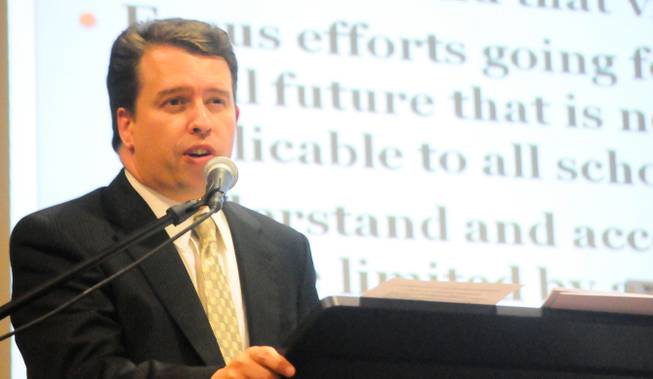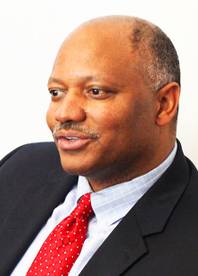
Clark County Schools Deputy Superintendent of Instruction Pedro Martinez answers questions about reforms to the struggling Prime Six schools in the historically disadvantaged neighborhood of West Las Vegas during a community input session on Tuesday, July 19. 2011.
Wednesday, July 20, 2011 | 2 a.m.

Dwight Jones
Sun Archives
- Rulffes has rough draft of fix for Prime Six (9-10-2009)
- What fine print of federal plan means for our local schools (9-2-2009)
- U.S. schools chief seeks big changes, has money to spend (8-30-2009)
- Sought: More schools like West Prep (8-27-2009)
- School District again taking heat for unequal achievement (8-16-2009)
Sun Coverage
Reforms that could begin as soon as next month at the Prime Six schools got a welcome reception from West Las Vegas residents Tuesday night.
More than 100 residents turned out to hear a committee’s plan for turning around the historically troubled elementary schools.
The Superintendent’s Education Opportunities Advisory Committee was tasked in March by Superintendent Dwight Jones with coming up with recommendations for the schools (now there are nine).
“We have always had support, but this is support in action,” committee co-chairwoman Beverly Mathis said. “Instead of talking about what we need to know, we’re now actually moving forward because our children they can’t afford waiting. It’s urgent.”
Tuesday’s meeting was the first opportunity for the public to comment on the committee’s recommendations, which were drafted in June. Reforms recommended by the committee include:
Keep the Prime Six schools together in one of Jones’ “performance zones” and hiring an academic manager to oversee the schools.
Consolidate district funding for each school into block grants, giving principals greater autonomy in exchange for greater accountability for test scores.
Implement high quality English Language Learner and early childhood programs for 3- to 4-year-olds in every Prime Six school.
Establish a three-year goal for demonstrated success at each school.
Study new uses for Kelly Elementary School, which has been significantly under-enrolled for several years.
Parents, educators and elected officials who turned out for the meeting seemed to largely approve the recommendations, applauding reforms such as early childhood programs.
“The key was to get some input from the community today,” Deputy Superintendent of Instruction Pedro Martinez said. “I was very happy with the turnout but I wish we would have had a little bit more of our Latino community here.”
School District officials also gauged support for reform using more than 100 wireless clickers, which instantly recorded public opinion via an electronic vote. The unscientific method polls found the majority of attendees were in support of the reforms.
Committee Co-Chairman Robert McCord added: “I thought they were generally supportive. “We have some real potential in making really positive progress in Prime Six. We’ll see.”
The nine elementary schools — Booker, Carson, Fitzgerald, Gilbert, Hoggard, Kelly, Mackey, McCall and Wendell Williams — have high minority populations and are in the historically disadvantaged neighborhood of West Las Vegas.
In early 1970s, West Las Vegas schools became ground zero for a federally mandated desegregation program. Black students were bused out of their neighborhoods to attend schools in outlying areas to promote racial diversity. At the same time, white students were bused into West Las Vegas to complete sixth grade.
The Clark County School District began dismantling the desegregation program in the early 1990s after West Las Vegas residents complained black students deserved the same opportunities as their white peers to attend quality schools close to home.
In response, the School District came up with the “Prime Six” plan, which gave students at six West Las Vegas elementary schools the option to be bused to other schools, stay at their neighborhood schools or attend other magnet and charter schools.
For almost 20 years, these schools were given additional resources: more than $3,000 per student for instruction, additional staffing, longer school days and student enrichment, such as field trips. Although some schools improved, a 2009 UCLA report commissioned by the School District found that student achievement in Prime Six schools still lagged behind the district’s average.
The report found test scores at most Prime Six schools were up to 15 percentage points below the districtwide average, and just two schools had made adequate yearly progress in 2008-09 under the federally mandated No Child Left Behind Act.
The report sparked community outrage, and the School District began — under former Superintendent Walt Rulffes — a plan to turn the schools around.
Rulffes’ reform plans included recruiting top teachers, expanding programs, encouraging community partnerships and teaching parents how to better help their children’s schooling.
The committee plans to present its recommendations and community findings in early August and to the full School Board by late August. Some reforms may be implemented by the start of the school year on Aug. 29.


Join the Discussion:
Check this out for a full explanation of our conversion to the LiveFyre commenting system and instructions on how to sign up for an account.
Full comments policy